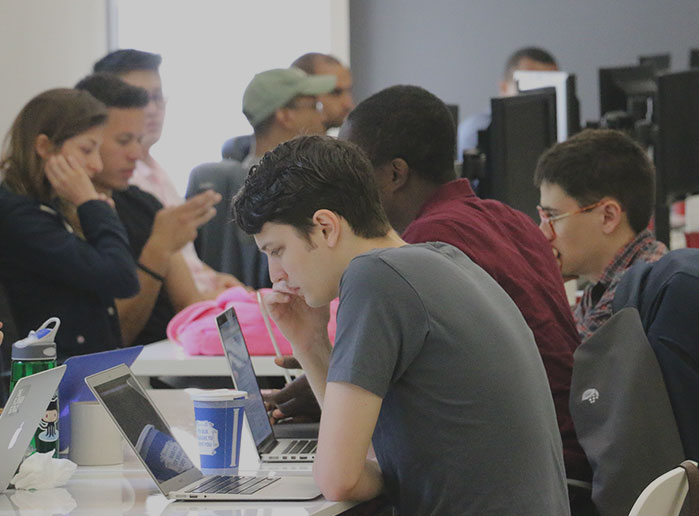The following post was written by guest author John Arthur from AND CO, a company that uses tech to help freelancers automate their businesses.
Starting a successful freelance career whether you are a web developer, designer, filmmaker, or in any other field, requires a lot of dedication. It may seem like the ideal lifestyle—you can make your own schedule, you can boost your income by picking up more or better paying clients, and you can work from the comfort of your living room or favorite coffee shop. But getting started, and growing your business, is difficult.
A successful freelancer must not only have skills in their chosen field, but must also know how to market their work, attract clients, and negotiate rates that will allow them to to pay bills and keep the freelance business afloat.
So where does one begin?
1. Acquire the Skills
First, you need to have a marketable skill. That might mean hitting the books (or, since it’s 2016, exploring the many free online learning resources out there). For aspiring programmers, of course, there are coding bootcamps like Flatiron School. No matter how you cut it, if you don’t have a skill, there’s no reason for anyone to hire you, but don’t get discouraged—with some dedication, you can learn enough to start your freelance business sooner than you might expect!
2. Build a Portfolio and Website
So now you’ve learned enough about your field to start your business. For anything creative, whether you’re a writer or a web designer, you’ll have to keep working on improving those skills, but fortunately you can do that while picking up clients and working on real, tangible projects. At the beginning, with just a few samples of your work to share, you may not be able to command the types of fees that you one day will. That’s okay. If you’re a web designer, start by making your own beautiful website and sharing it with prospective clients. If you’re a programmer, you can spend some time contributing to an open source project and sharing that work. Just don’t work for free forever.
As you pick up more clients and complete more projects, continue to update your website, online portfolio, and marketing materials, but the best form of marketing is the oldest: word of mouth. Do a great job for your clients and it could lead to more opportunities, not only for future work with those clients, but also with their colleagues and friends.
3. Finding Clients
There are endless ways to find clients, from websites like Upwork and Fiverr to the old-fashioned flier posted on a cork board at the local café. There’s also Craigslist, where plenty of companies look for freelance workers—you might be surprised by the opportunities you can find, but you’ll also have to sift through a lot of questionable posts. Once you complete a few projects, though, you can leverage those experiences, those contacts, and aim higher and higher—simply reach out to companies and offer your services. Keep at it until the clients start coming to you and your schedule is as full as you need it to be.
Don’t forget that, even though we live in the digital age, in-person connections are still crucial. Print out business cards. They’re an extremely cheap investment—if your cards land you one good client, they were worth it. Go to freelancer networking events—not only might you meet businesses looking for freelancers, you also might meet freelancers who hire other freelancers! For example, a web designer might be an absolute whiz with design, but may not be the strongest writer, so she hires a creative copywriter to create all of the text for every website designed. That’s an ongoing relationship that is mutually beneficial, and one that can create lifelong partnerships that keep the work flowing to all parties involved.
4. Sometimes It Pays to Think Local
There are opportunities all around you. Maybe the pizza shop around the corner needs a website—set-up a lunch meeting with the owner to explain the benefits of your services, and make sure to accept that free slice while you’re at it. Maybe your neighbor has a great idea for an app, but doesn’t know the first thing about creating an app. Maybe the local recreation department hasn’t updated their website since 1994.
The fact is, local businesses and organizations that could use your services won’t know that someone with your expertise lives right around the corner until you let them know.
5. Don’t Quit That Day Job (Yet!)
Many freelancers from a variety of fields started off by working on their freelance business part-time before going full-time. This, ultimately, is a decision that only you can make, and, of course, it depends on many factors.
It can be difficult to start a side business when you’re already working full-time—but you can get a lot done for an hour or two per night and a few hours per day on the weekends. It’s a lot of work, but how badly do you want to make this work for you?
As you earn more clients, bigger contracts, and grow your bank account, you’ll know when to make the leap and put in notice at your job. Or maybe you’ll always work your 9-to-5 while you freelance on the side—and that’s okay too.
6. Contracts and Taxes
When you start making enough money from freelancing, you will have to start paying your taxes quarterly. Fortunately, you can use great tools like AND CO to help you keep track of everything, review contracts, as well as to consult with a live “Chief Operator” who can answer your questions.
By making sure you have all your paperwork in good working order—from contracts with clients to invoices to 1099s, you’ll not only save yourself a ton of time, you won’t be worried that you’ve filed incorrectly. Not many things could be a bigger distraction from working on your freelance business than the IRS coming after you.
Once you start making enough money, it will pay to hire a good accountant. To begin, you can consult with the Freelancers Union website for a wealth of useful information.
7. Negotiate!
When you’re just starting off, you may have to take some jobs that don’t pay as well as you would like just to build your portfolio, but as your body of work and your client list grows, you will earn the luxury of being more selective with who you want to work with, and how much you will need to be paid to do a job. Let’s say you’ve been working as a freelancer for awhile and you’ve got a lot on your plate. A new prospective client sends you an email asking for rates—why not aim high? You’re already busy with all the work you’ve got in front of you, so any new work has to be worth your while, right? Of course, you can also aim too high and completely alienate a prospective client—but as you work on your negotiation skills you will learn to navigate this fine line.
8. Get to Work!
The most important thing you can do to get started is just that: get started! Sign-up for that school. Write your introductory marketing materials and send some of them out. Turn off Netflix (I know, just one… more… episode). Ask yourself: what’s the next thing I have to do to make my freelance business work? Whatever the answer is, do it. Do it now.
Written byFLATIRON SCHOOL
Make yourself useful.

